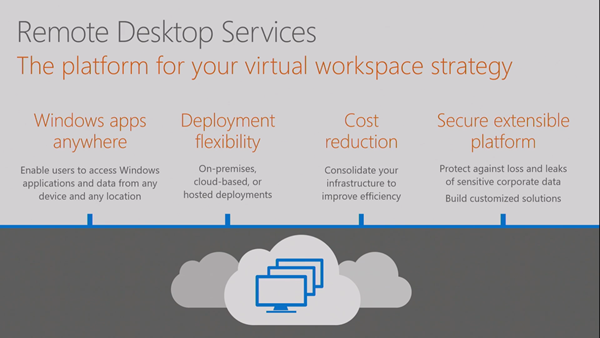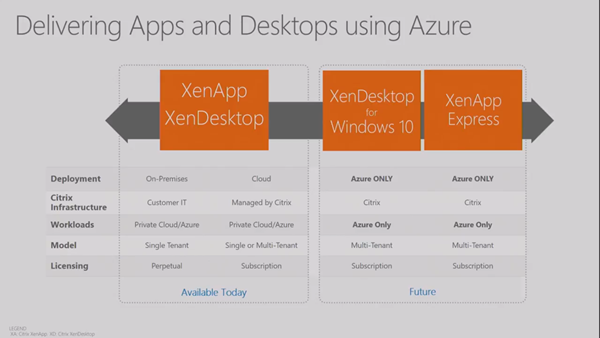Speakers: Gama Aguilar-Gamez & Sandeep Patnik
Goal: Make Office 365 Pro Plus a first class experience in virtualized environments.
Windows Virtual Desktop
- The only mutli-user Windows 10 experience – note that this is RDmi and it also supports session hosts.
- Optimized for Office 365 Pro Plus
- Deploy and scale in minutes
Windows 10 Enterprise Multi-User
- Scalable multi-user modern Windows user experience with Windows 10 Enterprise security
- Windows 10
- Multiple users
- Win32, UWP
- Office 365 Po Plus
- Semi-Annual Channel
This is a middle ground between RDSH on Windows Server and VDI on Windows 10.
Demo
The presentation is actually being run from a WVD VM in the cloud. PowerPoint is a published application – we can see the little glyph in the taskbar icon.
User Profile Disks
High performance persistence of cached user profile data across all Office 365 apps and services.
- Outlook OST/PST files – will be improved for GA of WVD. Support for UNC paths
- OneDrive sync roots
- OneNote notebook cache
Improving Outlook Start Up
- Virtual environment friendly default settings
- Sync Inbox before calendar for faster startup experience
- Admin option to reduce calendar sync window
- Reduce the number of folders that are synced by default
- Windows Desktop Search is no per-user
See Exchange Account Settings to configure how much past email should be synced
Windows Desktop Search
- Enables the full Outlook search experience that users expect
- Per user index files are stored in the user profile for each roaming
- No impact to CPU usage at steady state, minimal impact at sign in
With 100 users in a machine signing in simultaneously, enabling Windows Search has a 0.02% impact on the CPU.
Demo
Desktop of the remote machine is stretched across multiple displays – this demo is with a published desktop hosted in Windows 10 multi-user. Windows Desktop search is enabled. Instant search results in Outlook. OneDrive sync is working in a non-persistent machine – fully functional enabling the full collaboration experience in O365. Selective Sync works here too. Sync is cloud-cloud so the performance is awesome. In Task Manager, we see 3 users signed into a single Windows 10 VM via RDS.
OneDrive
- Co-authoring and collaborative capabilities in wXP, powered by OneDrive.
- OneDrive sync will run in non-persistent environments
- Files on-demand capabilities
- Automatically populate something
Support
- Search products stay in sync with each other
- Office 365 Pro Plus will always be supported with Win 10 SAC
- Office 365 Pro Plus won Windows Server 2016 will be supported through October 2025
Best Practices
Outlook:
- The OST file should be stored on local storage.
- Outlook deployed with the primary mailbox in cached echange mode with the OST file stored on network storage, and an aggressive archiving strategy to an online archive mailbox
- Outlook deploy in cached exchange mode with slider set to one month.
Office 365:
- Licensing token roaming: Office 365 Pro-Plus 1704 or newer. You can configure the licensing token to roam with the users profile or be location on a shared folder on the network. This especially helpful for non persistent VDI scenarios.
- SSO recommended. We recommend using SSO for good and consistent user experience. SSO reduces how often the users are prompted to sign in for activation. With SSO configured, Office activates with the credentials the user uses to sign into Windows if the user is also licensed for O365 Pro Plus.
- If you don’t use SSO, consider using roaming profiles.
Preview
Sign up: https://aka.ms/wvdpreview
Public preview later 2018.
GA early 2019.
Q&A
If you want to use RDSH on Windows Server 2019 then Office 365 Pro Plus is not supported. You would have to use persistent Office 2019 so you get a lesser product. The alternatives are RDSH on Windows Server 2016 or Windows 10 Multi User (Azure).
Widows 10 Multi User is only available in Azure via Windows Virtual Desktop.
A lot of the above optimization, such as search indexing, rely on the user having a persistent profile on the latest version of Windows 10. So if that profile is a roaming profile or a UPD, then this works, in RDS or on physical,








